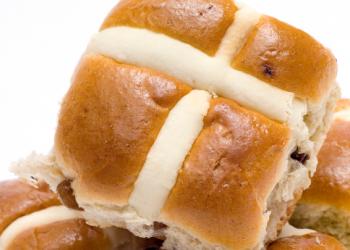In 1592, Queen Elizabeth 1 passed a law limiting the sale of sweet buns to funerals, Christmas, and the Friday before Easter.
It was the probably the first mention of Hot Cross buns although their origins may go back as far as the 12th century. According to the story, an Anglican monk baked the buns and marked them with a cross in honour of Good Friday.
But even further in Saxon times, cross buns were baked at the beginning of spring in honour of the goddess Eostre,most likely being the origin of the name Easter. The cross represented the rebirth of the world after winter and the four quarters of the moon, as well as the four seasons and the wheel of life.
Like many traditions the pagan and the Christian became mixed over time, the cross, the symbol of the Crucifixion and the resurrection of Christ at Easter.They may also be connected to Jewish Passover, with its sharing of unleavened bread as part of wider ritual
Queen Elizabeth’s law was not a great success, people began to bake them in the privacy of their own homes, superstition abounded, indeed it was widely believed the buns carried medicinal or magical properties. Some even believed that buns baked on Good Friday would never go stale.
One tale states that buns baked on this day and hung from the rafters of a home would ward off evil spirits in the coming year, another of buns protecting sailors from shipwreck, while off at sea while sharing the bun with a loved one guarantees friendship in the coming year.
The cry of one a penny two a penny hot cross buns can be traced to the 17th century, the Oxford English Dictionary’s first reference to hot cross buns comes from 1733 and comes in the form of the ditty: “Good Friday comes this Month, the old woman runs, With one or two a Penny hot cross Bunns.”
Should they be eaten only on Good Friday? Well nowadays they are sold all year round, in various forms but even back in the day when religion was a lot stronger. you can find some references to them being eaten during Lent.
Today the most common recipe has yeast, milk, flour, butter, eggs, sugar, raisins, and a combination of cinnamon, cloves, nutmeg and allspice, but some older recipes used saffron and mace.







